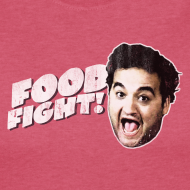Government Nannies Attack Food Trucks
by CalWatchdog Staff | March 8, 2012 9:11 pm
 [1]MARCH 9, 2012
[1]MARCH 9, 2012
By DAVE ROBERTS
A food fight has broken out between a liberal Democratic assemblyman and a liberal Democratic San Francisco supervisor over the banning of food vending trucks near schools. It’s a battle of nanny government officials — with the collateral damage being the livelihoods of mostly minority business people and the appetites of kids who just want something tasty to eat.
Last month Assemblyman Bill Monning[2], D-Carmel, introduced AB 1678[3], which keeps food trucks at least 1,500 feet away from elementary and secondary school campuses from 6 a.m. to 6 p.m. when school is in session. The bill’s argument states that food and beverages from the trucks “are calorie rich, nutrient poor, and contribute to negative health outcomes like being overweight and obesity.” The trucks should not be allowed to compete with school-provided breakfasts and lunches, “which are often more nutritious than meals brought from home or served elsewhere.”
In a press release[4] Monning said, “All students deserve access to healthful food. The mobile vending of unhealthful snacks like ice cream, chips and sugar-sweetened beverages near school campuses undermines efforts to provide students with the nutrition they need. At a time when childhood obesity is at epidemic levels, we must ensure that our school environments foster student wellness.”
AB 1678 will likely go before the Assembly Health Committee[5], which Monning chairs, in late March or early April.
Opposition
Normally such legislation would be wholeheartedly embraced by San Francisco politicians, who made national headlines in 2010 for banning McDonald’s Happy Meals[6]. But this week Supervisor Scott Wiener[7], who became a minor sensation himself last year with legislation requiring nude San Franciscans to place a towel under themselves before sitting in public, introduced a resolution opposing AB 1678[8].
The resolution points out that food trucks contribute to the diversity of San Francisco’s “thriving food scene,” and provide “a way for people without access to significant capital to enter the food industry,” particularly women and immigrants. It notes that in a densely populated city with numerous schools, the 1,500-foot ban, which is about three city blocks, “would dramatically reduce the locations available for food trucks,” placing some neighborhoods largely off-limits and result in a concentration of food trucks in a few areas like the downtown.
The resolution also points out that the 1,500-foot no-food-truck zone is 2½ times larger than the 600 feet that state law requires medical marijuana dispensaries to be away from schools.
“We should be making those decisions locally in San Francisco based on the needs of our urban, dense city,” said Wiener at Tuesday’s Board of Supervisors meeting. “Sacramento should not be imposing a one-size-fits-all solution that applies equally in San Francisco, Orinda, Anaheim. Eighty to 90 percent of the city would be off limits to food trucks if AB 1678 were to pass. It’s critically important that San Francisco make clear that the current form of the legislation is not acceptable to us.”
Wiener decided to postpone consideration of his resolution to March 13, however, to allow time for school officials to weigh in. No school officials spoke at the meeting, but a number of food truck owners, most of whom have Hispanic or Asian accents, did. A woman, who owns what she called “an organic and sustainable food truck,” said, “We do give healthy options. AB 1678 unfairly points out that we are not helping the children and contribute to obesity. I don’t feel that that’s the case. San Francisco needs to be able to make its own choices. This bill does not fit what San Francisco needs.”
San Francisco already has a 1,500-foot no-food-truck zone around middle and high schools. AB 1678 would expand that to include elementary schools. Wiener said he is considering legislation to reduce the distance from high schools to about 500 feet or one city block. He also questions why middle schools should have a no-food-truck zone because they are all closed campuses.
 [9]Possible Compromise
[9]Possible Compromise
Some compromise may be found. Wiener’s resolution, which calls for the state Legislature to reject AB 1678 or at least allow San Francisco and other cities to opt out, may be watered down before it comes back to the board. And Monning, who told the San Francisco Chronicle[10], “The goal here is not being food Nazis,” said he’s open to tweaking his proposal.
While the fate of AB 1678 has yet to be determined, the larger question is why food trucks, which charge for their food, are viewed as so much of a threat to school breakfasts and lunches, which are provided for free or at minimal cost. The reason is that for several years there has been an effort in California — and now nationwide, thanks to Michelle Obama and the nutrition elite — to force kids to eat “healthy” food, which doesn’t always mean tasty food.
Hot dogs and hamburgers on white buns, pizza with white dough and fatty cheese, baloney sandwiches on white bread, chicken nuggets, corn dogs and nachos — all washed down with chocolate milk — are either verboten or on the endangered food list[11]. Soft drinks and candy have, of course, been illegal on most campuses for years.
Instead the kids must make do with the likes of whole wheat pizza with low-fat cheese and low-sodium sauce, whole wheat spaghetti, whole grain fish nuggets, black bean burgers, jicama, broccoli, kiwi, cauliflower, green beans, carrots and tofu.
Student Rebellion
There was a student rebellion in Los Angeles schools last fall when jambalaya, vegetable curry, pad Thai, lentil and brown rice cutlets, and quinoa and black-eyed pea salads were introduced, according to a Los Angeles Times article[12]. Participation in the school lunch program reportedly dropped by thousands of students and underground markets in chips, candy and fast-food burgers sprung up. The article said that as a result of the uprising, the menu was being revised, eliminating some of the more exotic fare and bringing back pizza and daily hamburgers.
The article was inaccurate and overblown, according to Los Angeles Unified School District Food Services[13] Director Dennis Barrett. He acknowledged there were problems early in the fall getting delivery of meat dishes from the district’s food suppliers, resulting in a predominance of vegetarian offerings. The rollout of more exotic fare went through extensive testing and only those dishes receiving 75 percent approval from 30,000 tasters were approved.
“I have never had a year go by that a couple of times a year a group of student say ‘We want this,’” said Barrett in reference to fast-food type offerings. “We really try to work with kids and give them what they want. The number one thing we are working on now is staying with very healthy meals, that’s a direction we will maintain.”
Tasty Food
Most kids, of course, prefer tasty food to healthy food. In addition to the common criticism that whole wheat pizza tends to taste like cardboard, there’s the problem that most school food is prepared in a factory, frozen, stored in a warehouse, shipped to the schools and then heated up to eat. No matter how well done, it’s bound to have less flavor and texture than fresh food made with fresh ingredients, even if it’s provided out of a truck.
So, unless they bring their own food from home, if AB 1678 passes, many students will be forced to eat food they don’t like in the school cafeteria, or buy from an underground candy/fast-food dealer, or walk the three blocks off campus (assuming they’re allowed to leave) in an attempt to find a food truck. If food trucks are banned from school zones, will fast-food restaurants be next?
Nanny Michelle
None of which appears to be a concern of Michelle Obama, et al. Last month the federal government finalized new nutrition standards[14] starting in the 2012-2013 school year for nearly 32 million students. They require schools to serve more fruits and vegetables (including legumes, dark green and orange vegetables every week), switch to whole grains and limit the sodium and calories in each meal.
“As parents, we try to prepare decent meals, limit how much junk food our kids eat, and ensure they have a reasonably balanced diet,” said Michelle Obama[15]. “And when we’re putting in all that effort the last thing we want is for our hard work to be undone each day in the school cafeteria. When we send our kids to school, we expect that they won’t be eating the kind of fatty, salty, sugary foods that we try to keep them from eating at home. We want the food they get at school to be the same kind of food we would serve at our own kitchen tables.”
But it’s likely that many students will not stomach the changes. When the requirements were being drafted, 430 people registered their opposition[16], predicting the following:
* They would result in decreased participation in the meal programs because the food offered would not be acceptable to students. Decreased participation rates would lead to decreased revenues, which could lead some schools to stop offering meal service.
* They would result in increased plate waste because of increased portions and the proposed requirement that a reimbursable meal must include a fruit or a vegetable.
* Increased plate waste, increased produce requirements and increased whole grain requirements would result in increased costs for schools which would result in schools having to raise meal prices, which may impact participation rates.
Whether the nannies are in San Francisco, Sacramento or the White House, the governmental meddling in people’s lives — right down to what they put in their mouths — will continue to escalate. You might want to stock up on those Snickers bars before they go the way the way of the incandescent lightbulb[17].
- [Image]: http://www.calwatchdog.com/wp-content/uploads/2012/03/Belushi-food-fight.png
- Assemblyman Bill Monning: http://asmdc.org/members/a27/
- AB 1678: http://www.leginfo.ca.gov/pub/11-12/bill/asm/ab_1651-1700/ab_1678_bill_20120214_introduced.pdf
- a press release: http://asmdc.org/members/a27/news-room/press-releases/item/3217-legislation-to-curb-mobile-food-vending-near-schools-is-introduced
- Assembly Health Committee: http://ahea.assembly.ca.gov/
- banning McDonald’s Happy Meals: http://articles.latimes.com/2010/nov/02/business/la-fi-happy-meals-20101103
- Supervisor Scott Wiener: http://www.sfbos.org/index.aspx?page=11325
- a resolution opposing AB 1678: http://www.sfbos.org/ftp/uploadedfiles/bdsupvrs/bosagendas/materials/bag030612_120205.pdf
- [Image]: http://www.calwatchdog.com/wp-content/uploads/2012/03/Soup-Nazi.jpg
- San Francisco Chronicle: http://www.sfgate.com/cgi-bin/article.cgi?f=/c/a/2012/02/29/MNLF1NDH3E.DTL
- verboten or on the endangered food list: http://www.usda.gov/documents/cnr_chart.pdf
- Los Angeles Times article: http://articles.latimes.com/2011/dec/17/local/la-me-food-lausd-20111218
- Los Angeles Unified School District Food Services: http://cafe-la.lausd.net/
- new nutrition standards: http://www.fns.usda.gov/cnd/Governance/Legislation/nutritionstandards.htm
- Michelle Obama: http://usda.gov/wps/portal/usda/usdahome?contentid=2012/01/0023.xml&navid=NEWS_RELEASE&navtype=RT&parentnav=LATEST_RELEASES&edeployment_action=retrievecontent
- 430 people registered their opposition: http://usda.gov/wps/portal/usda/usdahome?contentid=2012/01/0023.xml&navid=NEWS_RELEASE&navtype=RT&parentnav=LATEST_RELEASES&edeployment_action=retrievecontent
- incandescent lightbulb: http://en.wikipedia.org/wiki/Phase-out_of_incandescent_light_bulbs
Source URL: https://calwatchdog.com/2012/03/08/government-nannies-attack-food-trucks/